In their Wetlands Request for Determination of Applicability (PDF) filed with the city last month, Kohl Construction portrays the wetlands between North Street and the bike trail as “degraded”, partly because there’s a grain of truth to this and partly (presumably) to make people feel less bad about development in this area.
Kohl’s Area Description: The area of the two parcels combined is approximately 5 acres. There is an intermittent stream that flows from the north, through a culvert under the new bike path. The stream is also fed by the storm drain system on Northern Avenue, which flows into the swale adjacent to the bike path. There are bordering vegetated wetlands associated with the intermittent stream. The wetlands are degraded with masonry and other construction and road building debris, as well as invasive plant species.
While it’s true that fill from past work on Market Street was dumped into these wetlands, nature has been hard at work reclaiming this space. For example, we believe the hummock towards the back of this picture is one of the main piles of fill in the area:
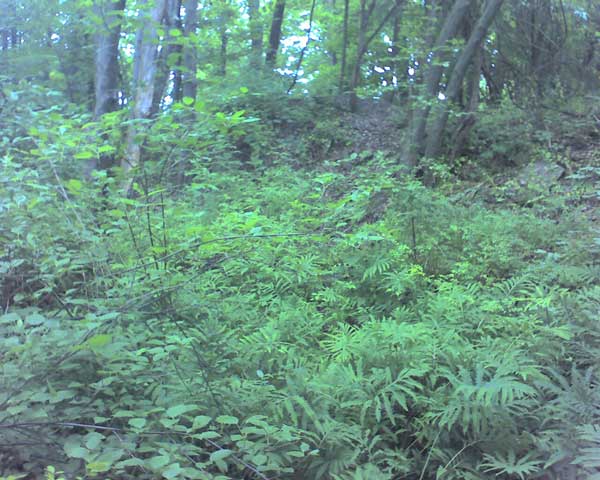
More pictures from the area show its substantial natural beauty and mature trees–this is no urban brownfield. It includes numerous edge zones between wetland, forest and meadow. These edge zones, key areas of biodiversity, are threatened by Kohl’s 31-unit condo proposal, its attendant roads and parking spaces, and more generally by a proposed ordinance to reduce the buffer area around many of Northampton’s wetlands from 100 feet to as little as 10 feet.
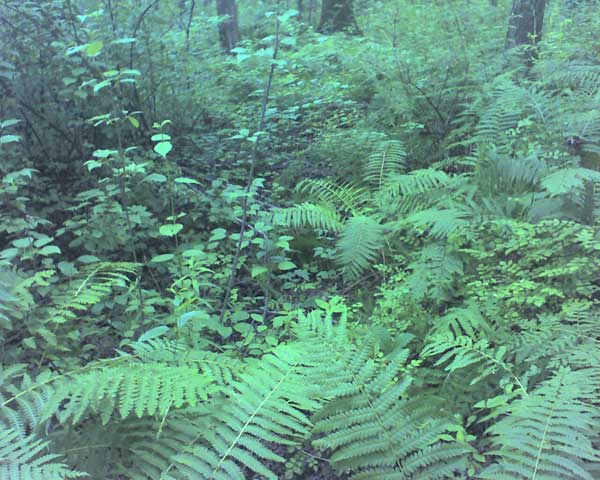
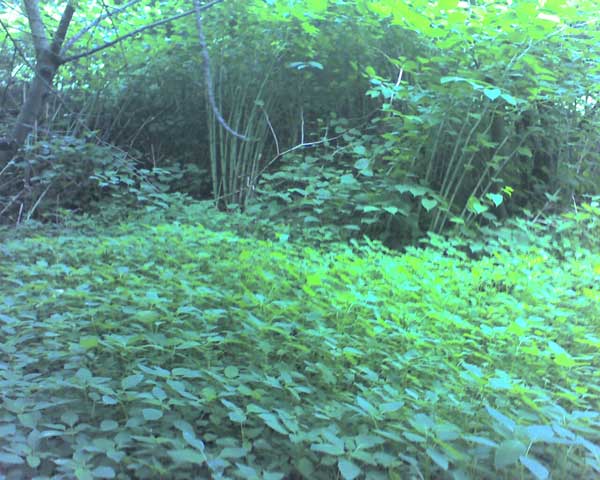
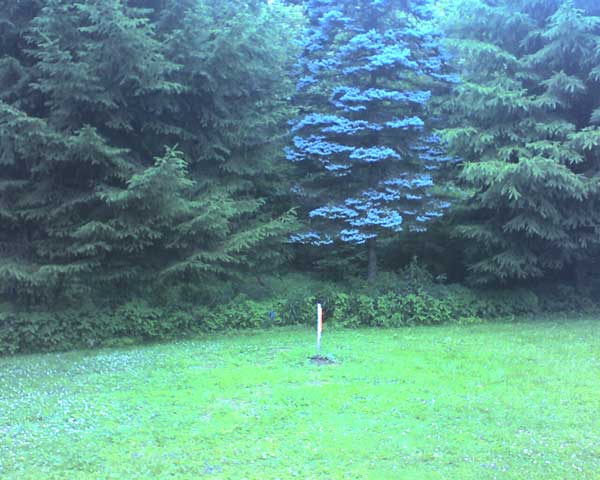
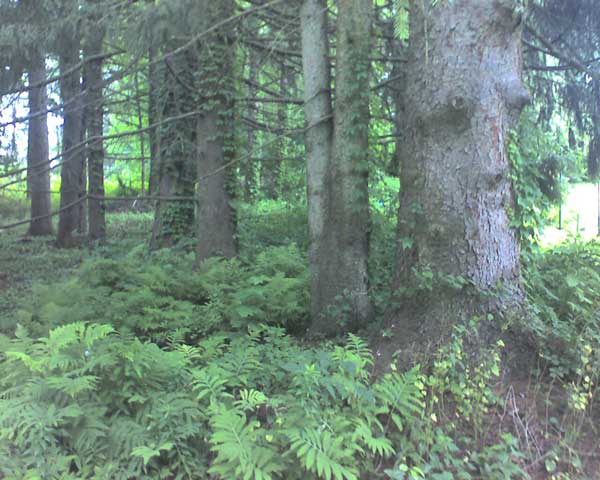
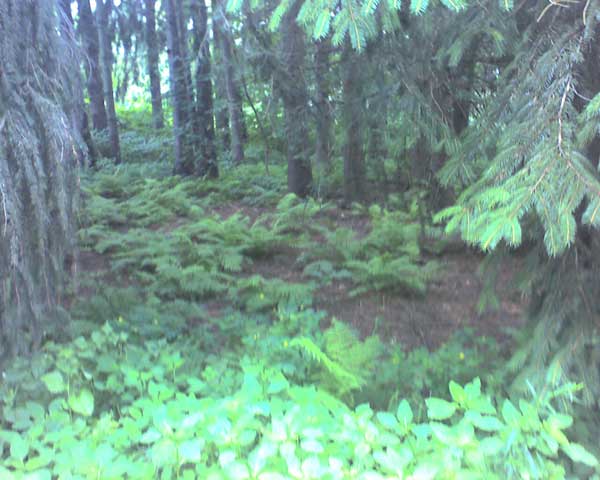
The Urban Outback provides an extended discussion of the benefits of urban wetlands and edge habitats. We quote from it here (emphasis added):
The 13th century Chinese referred to small lakes as “ponds of mercy”. As more and more wetlands disappear, the remaining pools become important amphibian refuges, or “ponds of mercy”… They symbolize our determination to ensure that we do not have a silent spring, and that the health of the entire landscape is restored…
[Caption:] Toads enjoy moist areas where ferns grow.…Assuming that your community has a wetland where amphibians breed, your frog friendly backyard may provide a summer fern glade in which a frog or toad can find shelter and moisture (remembering they need to absorb water through the skin and avoid drying out)… Although building a pond in your backyard will increase amphibian habitat, it will not be of much help if the wetlands in your area are being destroyed. Despite our best intentions, backyard ponds cannot replace the functions of existing wetlands which are survivors of a long evolutionary history.
Buffers may provide a transition between wetlands and terrestrial upland sites. These edge environments often have a high species diversity. The quality, size and connectedness of upland habitats are important as water sources and watershed diversity. Playing fields, pathways, hydro and rail corridors are routed through buffer areas, or inadvertently serve as buffers. In many urban areas river valleys, hydro and rail lines are the most undisturbed habitats available and wild life seek refuge in these areas. Buffers should not be fixed with some predetermined size but relate to the sensitivity and function of the adjacent land scape. Buffers, often designated at 30 metres, should conform to the local landscape and its use by wild life for seasonal aspects of their life history. For example, wet seepage areas, small inflow streams, field or meadow catchment areas, or woodlots should be included as an integral component of the wetland, and the buffer in this landscape design might extend several hundred metres…
Ephemeral (often referred to as vernal or temporary) ponds are depressions which temporarily hold water on poorly drained soils. Vernal pools require sufficient catchment area for recharge; contours to hold water long enough to balance losses to infiltration or evaporation; and impervious soils to hold water. These are easily and frequently drained, often accidentally, when drainage is “improved”, or water diverted due to minor alterations in soil elevations.
Ephemeral ponds are rarely mapped or protected and may contain a significant amount of water in the watershed. The abundance of ephemeral ponds in headwater areas buffer downstream peaks in water flow and ensure a steady supply of water long after rain falls. The loss of the water retention function of ephemeral ponds high in the watershed often necessitates downstream storm water control measures. It is much more effective to retain this upstream function than to try to restore wetland functions in downstream areas due to limited space and water volumes.
Swamps are some of the most threatened wetlands. Retaining existing swamps or rehabilitating those that have ben drained are top priorities in wetland conservation. The hard wood swamp is the hardest to recreate. We rarely have time for a community to develop from seed.
See also:
Kohl Construction’s Wetlands Application
Here for your reference is Kohl Construction’s Wetlands Application
(PDF) relating to its proposed condos behind North Street. Kohl is
doing this project under the business names Northern Avenue Homes, Inc.
and Tofino Associates, Inc. In the application, Kohl asserts there are
no existing or potential vernal pools on the development site.
Pictures of Kohl Construction’s Condo Plans
Total Parcel Size: 5.49 [acres]
Total Number of Units Proposed: 31
Total Parking Spaces Proposed: 66
The proposed condo units, access roads and parking spaces will impact the edge zones around Millyard Brook’s wetlands:
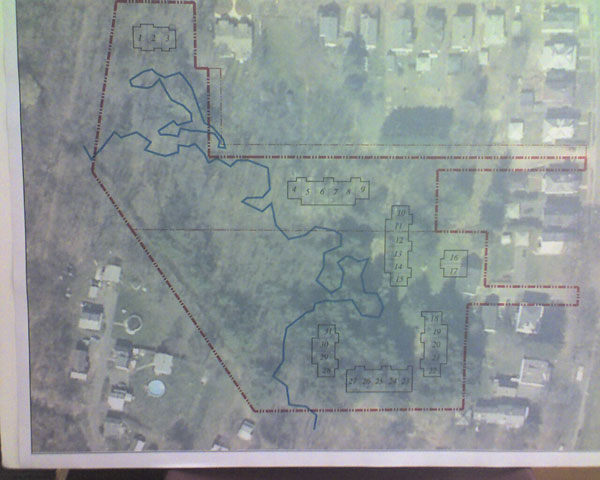
Note below the planned artificial “detention pools” to manage the substantial water flows in this area. As discussed, these are inferior substitutes for naturally-evolved forests and wetlands.
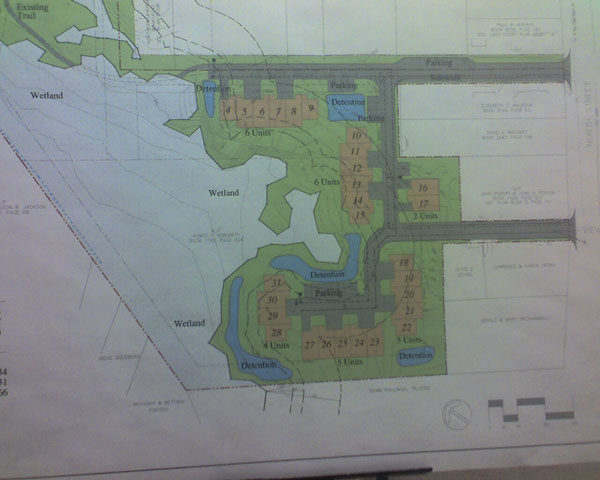
Wetlands Issues in Urbanizing Areas
In many urban areas, wetlands are among the last remnants of natural vegetation in the landscape. Wetlands are thus important elements of the natural capital of urban ecosystems. They often serve or are expected to serve multiple functions within the system: stormwater detention, water storage, treatment of wastewater/water quality improvement, maintenance of wildlife habitat, human recreation, education, and aesthetics. As more land in the surrounding area is converted to development, and population densities and demography change, increasing pressure is placed on those wetlands that remain to serve these multiple functions, some of which are incompatible…
For example, intense pressure on a site for human recreation may lower its quality as wildlife habitat. Excessive human visitation can imperil some rare species…
Urban Wetlands for Stormwater Control and Wildlife Enhancement
Abstract: Underdeveloped land absorbs much of the water which falls
during a rainstorm. However, urban development (which results in much
of the land being covered by buildings and pavement) increases the
extent of impervious land surface over pre-development conditions. This
results in greater post-development runoff of the urban stormwater…
Wetland Values
Wetlands were long thought to be a nuisance because they were not suitable for development or most kinds of agriculture. We now realize that wetlands are not just valuable, they are invaluable. The following is a list of ways in which wetlands benefit people and the environment…
Flood damage control: Wetlands adjacent to rivers (riparian wetlands) can easily survive inundation by floodwaters and often actually benefit from regular flooding. Water that is allowed to flow over wetlands is slowed and partially absorbed, thereby reducing flood damage downstream. Wetlands are said to act as sponges because wetland soils can readily absorb water, and depressions associated with wetlands can fill up. This has the effect of trapping and slowly releasing water that would otherwise rush into the channel and contribute to flooding downstream…
Water supply and groundwater recharge: Wetlands act as sources of water even in very arid regions. A properly functioning wetland can provide water for humans, livestock, and wildlife. Water flows out of wetlands and into the water table below neighboring habitats as these habitats dry out. This process is known as groundwater recharge, and helps habitats around wetlands survive drought. This slow release of stored water also helps rivers maintain flows in the summer.
Water purification: Not only do wetlands act as a sponge, they also act as a filter. Certain types of wetlands are efficient at removing toxins, and excess nutrients from surface and ground water… Wetlands also control sediment by decreasing the volume and velocity of flows during high water events which decreases channel erosion.
Recreation and aesthetic values: Many wetlands in or around urban areas have not been developed due to the difficulty of draining and clearing wetlands. These areas offer a great opportunity to preserve open space near developed areas. Wetlands and the wildlife they attract are increasingly viewed as appealing by land owners and communities. Although they are often difficult to explore, wetlands offer unique and rich recreational opportunities, including hunting, fishing, birding, canoeing, and hiking. Wetlands are also wonderful subjects and locations for education and research. It is critical that we understand how wetlands function because they are ecologically important and imperiled.
Fish and wildlife habitat: …Wetlands provide food, cover and water for a wide variety of wildlife. Many species of waterfowl utilize wetlands like prairie potholes for resting during migration, and breeding. Other birds are drawn to the nesting cover provided by dense shrub thickets… These same thickets are a good food source for deer and moose. Other animals like salamanders and some insects require the water conditions found in wetlands to live and reproduce…
Biodiversity: …Regardless of the diversity within a wetland, wetlands include plant and animal communities that increase the diversity of the landscape. Many plant and animal species have evolved in specific kinds of wetlands and can live nowhere else. To ensure the survival of these species, the wetlands they live in must be protected. View more wetland values. EPA resource on wetland values.
Wetland Function and Values (PDF, emphasis in original)
WILDLIFE AND WILDLIFE HABITAT
Many animals, most obviously fish, depend entirely on the water in wetlands to survive.
There are also other animals, such as amphibians, that live most of their lives in upland areas
but depend on wetlands for breeding. Spring peepers are small frogs that live in the woods
during most of the year, but return to wetlands each spring to breed. If you live near
wetlands, you may hear the chorus of peepers in a spring night. If a swamp is filled for
development, local populations of spring peepers would disappear completely.
Many mammals, amphibians, reptiles, and birds depend on wetlands for feeding, nesting,
escape cover, migration stopovers, and wintering habitat. Plants also grow and flourish in
wetlands. Vegetated wetlands serve as important nurseries for many young fish. Even
small wetlands that appear dry much of the time are crucial to the survival of certain species.
One type of seasonal wetland is the vernal pool. Vernal pools are most visible during the
spring months, but may be dry at other times during the year. This seasonal fluctuation
prevents them from supporting a fish population. Without the threat of fish, vernal pools
are attractive areas for amphibian breeding. Rhode Island’s vernal pools are critical
breeding areas for wood frogs and spotted salamanders. Without vernal pools and other
wetlands these species would vanish from the landscape.
More than one-third of all threatened and endangered wildlife species in the United States
live only in wetlands and nearly 50% of all threatened or endangered species use wetlands
at some point in their lives. Many rare native plants and animals of Rhode Island also
depend on wetlands for survival, such as the yellow lady slipper, American bittern, and
leopard frog…
FLOOD PROTECTION
Wetlands help control floodwaters by storing excess water during heavy periods of rain and
snowmelt. During and after a storm, rainwater flows to low-lying areas, which may be our
floodplains and swamps. Trees, roots, soil, and other vegetation hold the excess water until
it can be slowly released into streams and rivers. This process helps reduce the risk of
flooding into nearby homes.
Urban wetlands are particularly important because they help prevent flooded basements,
parking lots, and roads. When wetlands are filled or altered, their ability to hold floodwaters
is crippled. In 2001 the Pocasset River Watershed suffered one of many severe floods. This
flooding was due to approximately 700 acres of wetland loss since 1939, much of which
was floodplain loss. As a result, in the highly urbanized and industrial areas of Johnston and
Cranston, there is nowhere for the water to go during heavy periods of rain resulting in
flood damage to private properties. It is easier and less expensive to maintain existing
wetlands than it is to engineer and create stormwater drainage systems to handle the
water.
SURFACE WATER AND GROUNDWATER
Wetlands also provide key links in the water cycle. Many wetlands help to maintain stream
flow and aquatic resources through much of the year by releasing water from both surface
and groundwater storage. Their ability to store and slowly release water after storms not
only prevents flooding, but also helps to keep streams flowing when they might otherwise
be dry. Continually flowing streams provide water for our plant and animal communities, as
well as for drinking water and recreation…
FOOD, JOBS, AND THE ECONOMY
The amount of plant material produced in many wetlands is comparable to tropical rain
forests and greatly exceeds that of temperate forests or grasslands. The large amounts of
plant material from wetlands serve as the base for food chains that support many animals…
WATER QUALITY PROTECTION & IMPROVEMENT
Wetland soils and plants naturally treat stormwater pollutants and filter excess nutrients out
of rainwater by absorbing the pollutants before the water reaches rivers, streams and lakes.
Wetland plants also help to remove sediment and debris by slowing the velocity of the
water and allowing sediment to settle out before the water continues on its course. This
natural treatment system helps to improve water quality in rivers and streams. Healthy
wetlands are then able to support wildlife, supply high quality water to reservoirs, and
provide clean recreational water areas for fishing and swimming…
It is important to remember that although wetlands have the ability to cleanse storm and
waste water, if they are used solely for this purpose they can become clogged and
degraded, thus greatly reducing their benefits.
RECREATION AND AESTHETICS
…activities such as hiking, photography,
bird watching, education, and nature study may not be dependent on the presence of
water, but are often enhanced by and focused around wetlands.
The quality of a recreational activity depends, to a great extent, on the health of the wetland
system. For example, the perch or pickerel in a fishing pond will only be healthy if the
streams and groundwater that feed the pond are healthy. Fish from ponds and streams
that are contaminated with urban or industrial runoff may no longer be safe to eat.
Protecting wetlands helps to ensure safe and healthy fish.
Wetlands are also important because they provide attractive open space in increasingly
urbanized areas…